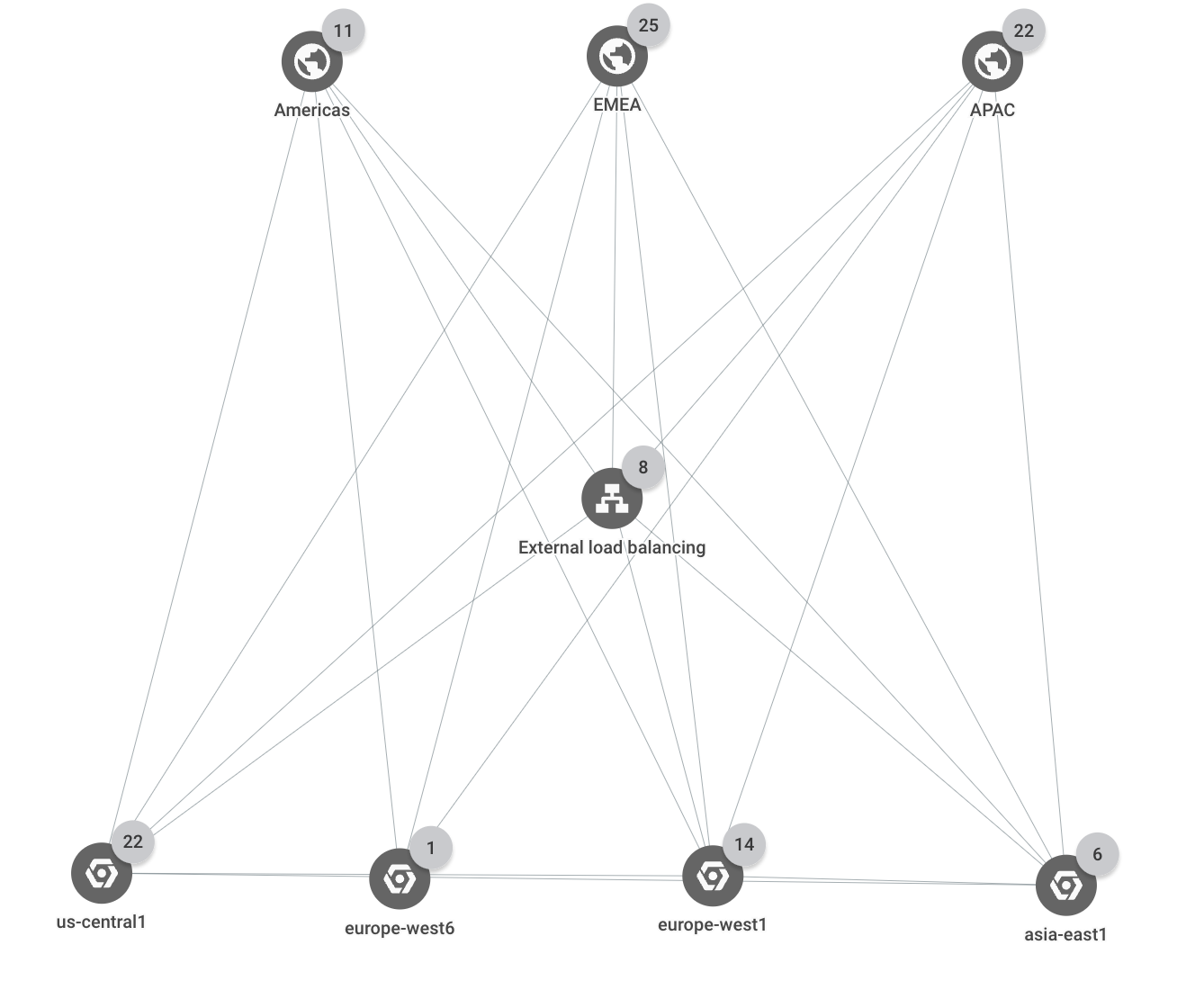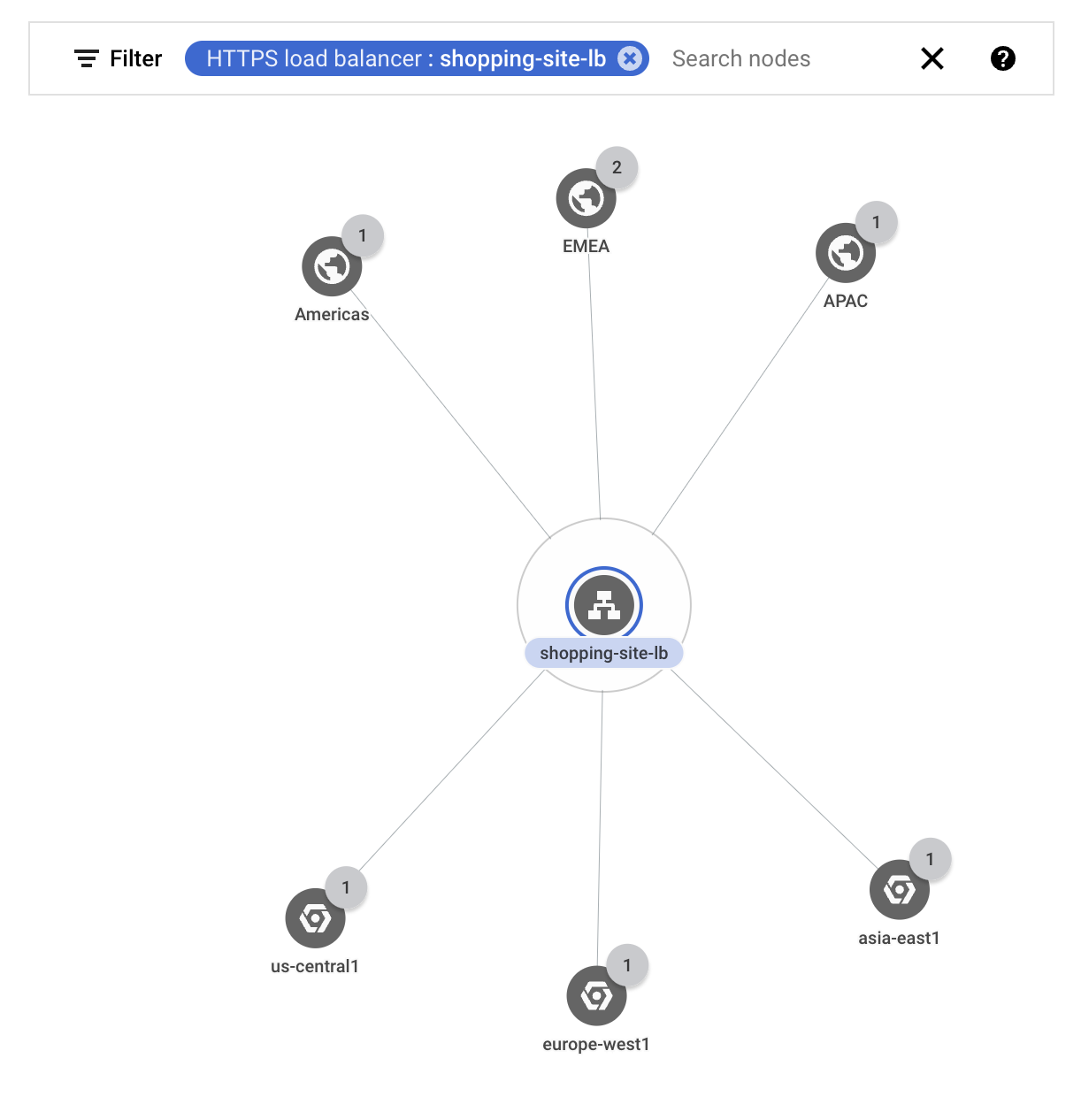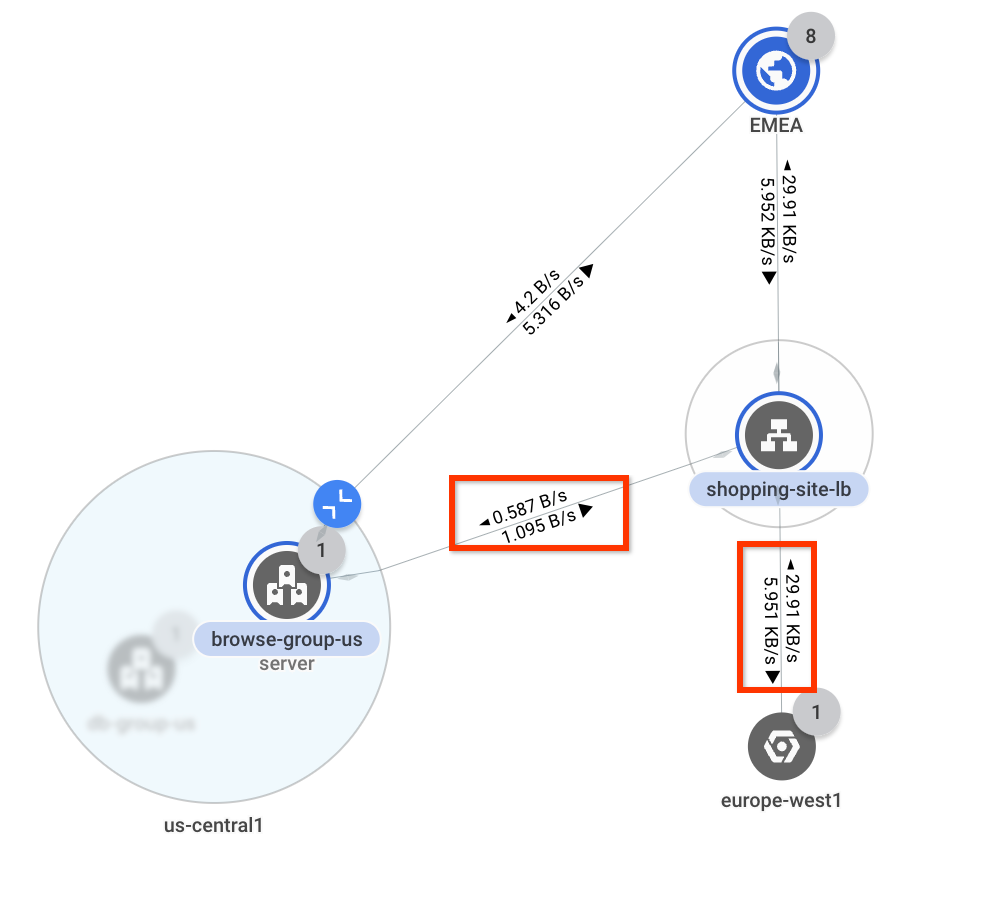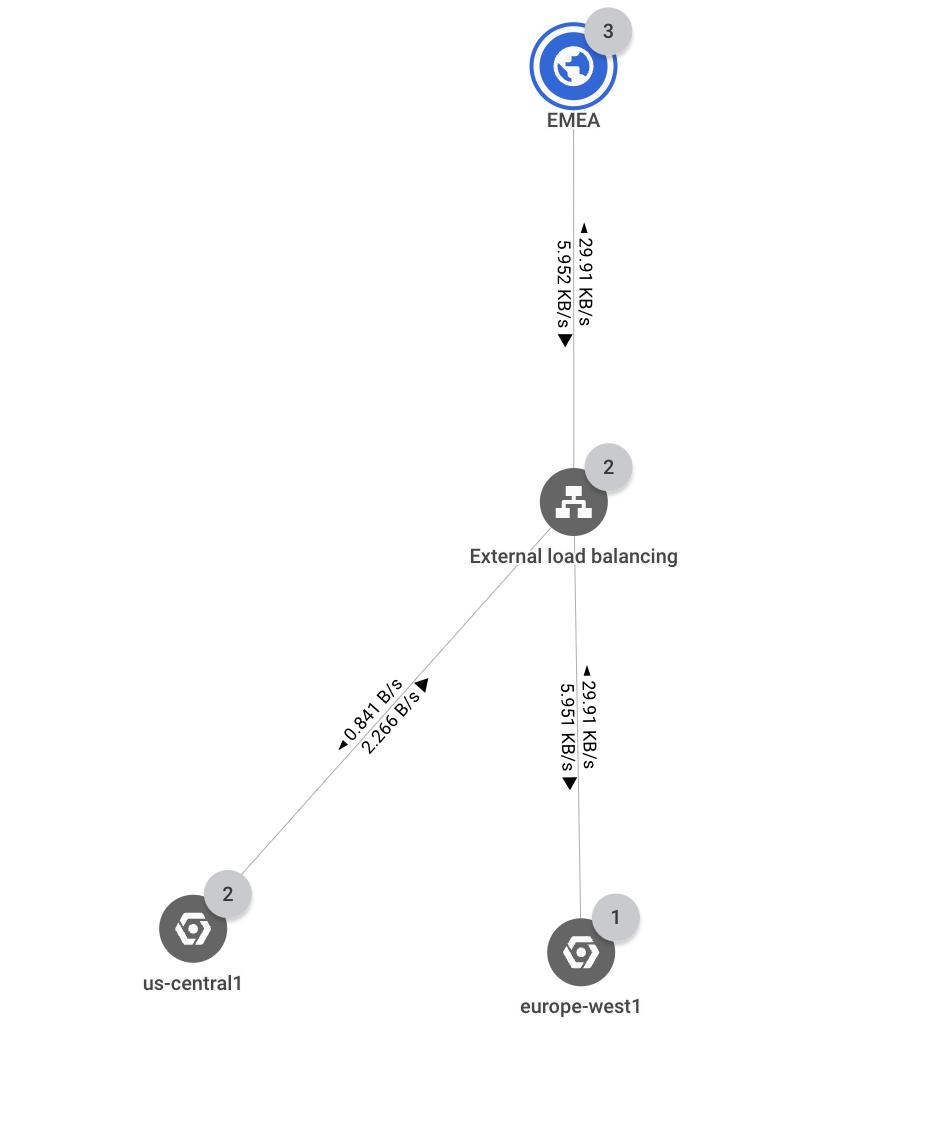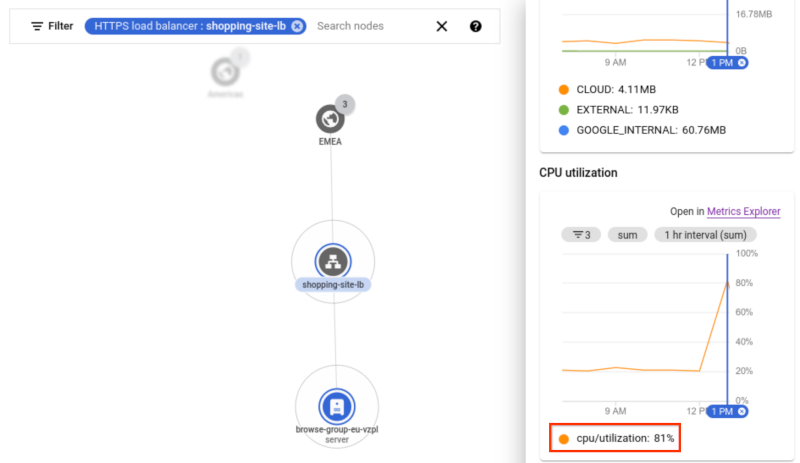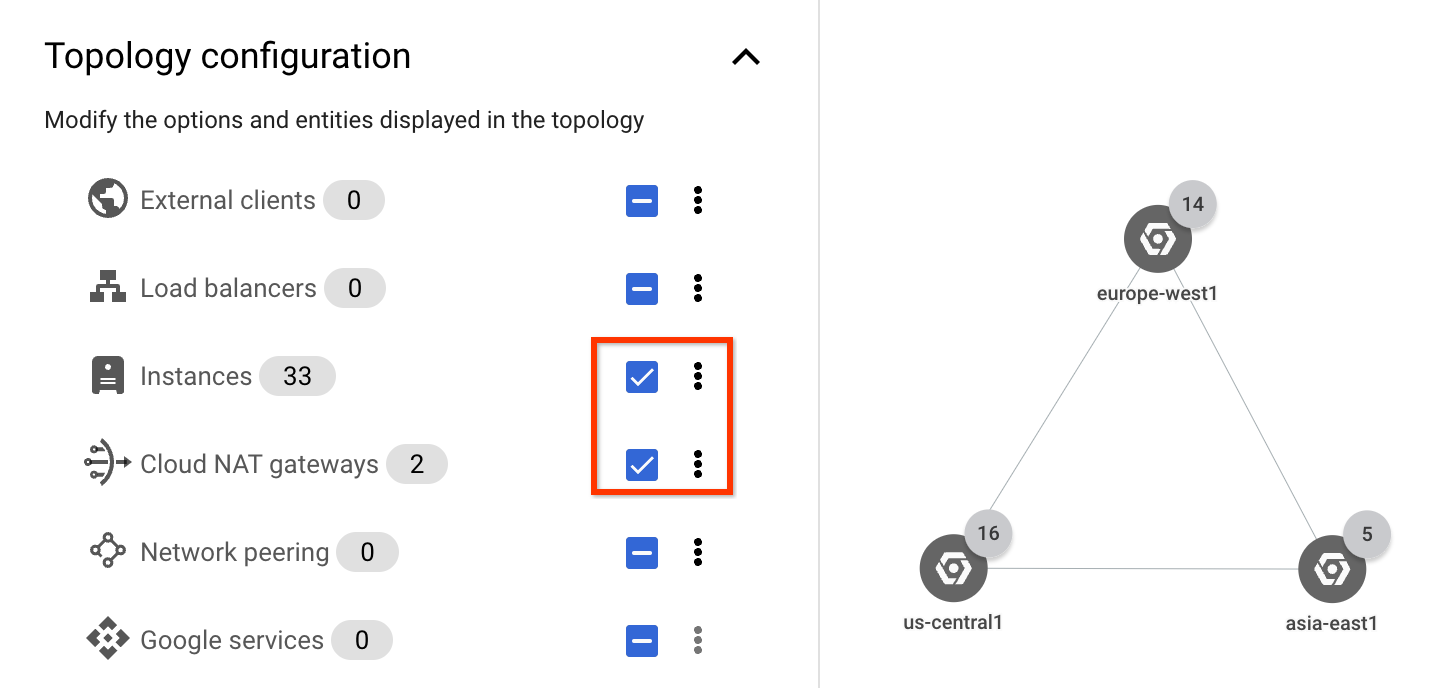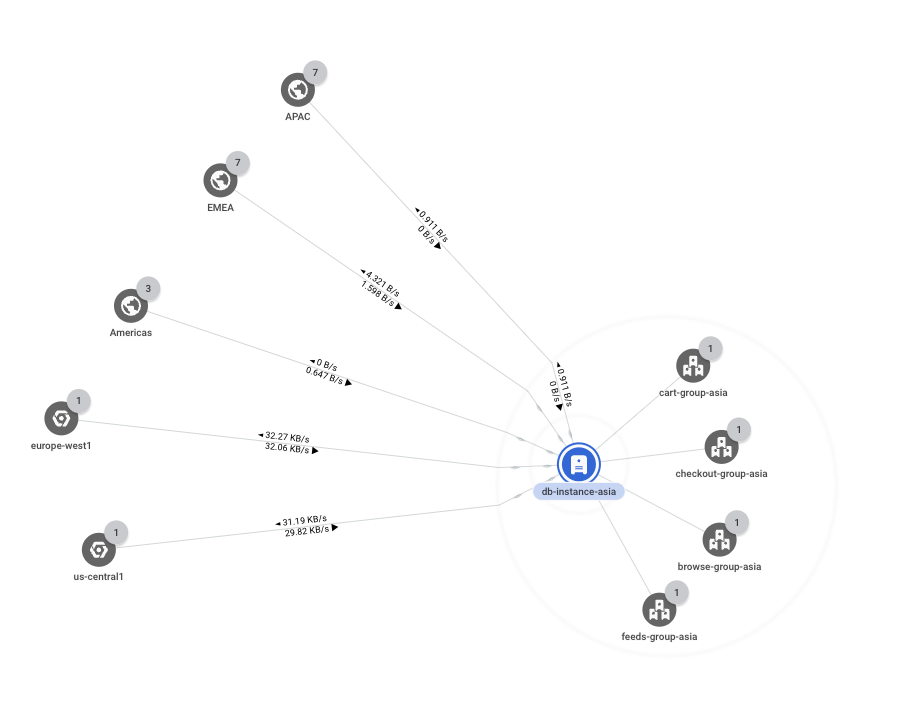用例:审核网络性能
假设您是负责支持包含多个负载均衡应用的网络的网络管理员。您被要求审核支持那些应用的网络配置,以确保配置与网络的预期状态保持一致。通过执行此审核,您可以确保客户获得的应用延迟时间尽可能短。
以下用例演示了网络拓扑如何帮助您检查现有配置。例如,您可以检查所有客户端请求是否由与客户端最近的 Google Cloud区域中的应用实例处理。您还可以确保跨区域流量较低,因为该流量来自全局复制数据的数据库。
拓扑概览
该部署跨越三个 Google Cloud 区域(us-central1、europe-west1 和 asia-east1)。所有外部客户端请求均由单个外部应用负载均衡器处理,该负载均衡器在三个区域的每个区域中都有多个后端。最近的Google Cloud 区域中的应用实例负责处理来自三个业务区域(美洲、欧洲、中东和非洲地区以及亚太地区)之一的客户请求。
下图显示了该部署的顶级层次结构。
资源和流量路径
在此示例中,项目包含以下 Google Cloud资源:
1 个 HTTPS 负载平衡器
4 个后端服务:
browse、shopping_cart、checkout和feeds12 个实例组(它们是负载平衡器的后端)
在这三个地区中,每个后端服务都有一个实例组。
3 个数据库实例,每个地区一个
您预计来自某些国家/地区的流量会进入以下位置:
- 来自
Americas业务地区的国家/地区的流量会进入us-central1地区的后端。例如,来自加拿大外部客户的流量会通过负载均衡器到达us-central1区域中的checkout后端。 - 来自
EMEA业务地区的国家/地区的流量会进入europe-west1地区的后端。例如,来自波兰外部客户的流量会通过负载均衡器到达europe-west1区域中的checkout后端。 - 来自
APAC业务地区的国家/地区的流量会进入asia-east1地区的后端。例如,来自日本外部客户端的流量会流经负载均衡器进入asia-east1区域中的checkout后端。 - 传输到数据库实例的流量来自同一地区中的后端。例如,
asia-east1中的后端仅会将数据发送到asia-east1中的数据库实例。 - 跨区域流量仅限于数据库复制。例如,
us-central1和europe-west1之间的流量仅会在这些区域中的数据库实例之间传播。
意外的流量
在此情景中,您发现来自EMEA业务区域的流量现在将进入两个不同的 Google Cloud 区域:us-central1 和 europe-west1。通过使用网络拓扑,您发现某个后端被过度利用。
您想检查通过负载均衡器的外部流量最终是否流向正确的 Google Cloud 区域。您可以过滤图表以仅显示外部负载均衡器
shopping-site-lb的流量。应用过滤条件后,网络拓扑仅显示与负载均衡器相关的连接,如以下示例所示。
您将鼠标指针悬停在每个业务地区上,以突出显示与该地区的通信。
将鼠标指针悬停在美洲和亚太地区上时,您会看到流量进入最近的 Google Cloud 区域:分别为
us-central1和asia- east1。但是,将指针悬停在欧洲、中东和非洲地区上时,您会看到流量进入us-central1和europe-west1。理想情况下,为了减少延迟,来自欧洲、中东和非洲地区的所有流量都应进入europe-west1。接下来,您点击欧洲、中东和非洲地区来研究它与Google Cloud 区域之间的吞吐量。网络拓扑会覆盖每个连接的带宽值。您可以看到流量进入
us-central1的速度约为每秒 0.58 字节,进入europe-west1的速度为每秒 29.9 千字节。您知道大多数流量都按预期定向,但是有些流量正在流向us-central1。1该图仅供参考。它的数据不能反映具体用例。
为了进一步调查,请展开
us-central1以查看流量方向。因为在该地区中只有一个网络具有单个子网,所以网络拓扑不会显示层次结构的那些级别,而是跳到实例组。您会看到流量进入与负载平衡器的后端服务关联的实例组。由于进入
europe-west1的流量相对较少,因此europe-west1中的资源可能会被过度利用,并导致流量溢出到us-central1。1该图仅供参考。它的数据不能反映具体用例。
为了证实您的结论,请展开
europe-west1区域,直至到达与同一负载平衡器的后端服务关联的实例为止。网络拓扑在该实例的详细信息窗格中显示时间序列图表。在图表中,您注意到该实例的 CPU 利用率为 81%。此示例的阈值为 80%,指示该实例已超额订阅。您可以通过纵向扩容实例组来解决此问题,以便流量返回理想的流向。
1该图仅供参考。它的数据不能反映具体用例。
区域间流量
在以下部分中,您检查各区域之间的内部流量是否仅限于数据库实例流量。
如需关注内部流量,请在拓扑配置列表中仅选中实例和 Cloud NAT 网关复选框。因为您只查看应用中的流量,所以不需要查看外部客户端和外部负载均衡器流量。
展开
asia-east1地区,然后看到 5 个实例组。这些实例组不按网络、子网或可用区聚合,因为它们都在同一网络、子网等中。您会注意到,只有一个实例组 (
db-group-asia) 包含区域间流量的路径。所有其他实例组均在该区域内进行通信。您继续展开
db-group-asia组,直至到达基础实体。在此场景中,基本实体是充当数据库服务器的虚拟机实例 (db-instance-asia)。它正在与其他区域进行通信以复制数据,这正是您所期望的,因此不需要进一步的研究。̦1该图仅供参考。它的数据不能反映具体用例。

